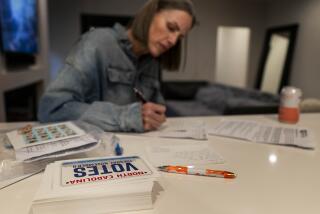At the Voting Booth, a Graphic Example of the Power of the Visual
We tend to take design for granted until it intrudes on little matters like the leadership of the free world.
We pick our candidate, we punch a hole, voila, an exercise in democracy. But in Florida, this civic ritual may have been subverted by an unexpected culprit: bad design.
The electoral ballot that has put the American presidential election on hold shows how dots, lines and arrows can subtly, and not so subtly, shape our lives. In Palm Beach County, some voters have complained that they were confused by a ballot that was redesigned to make it easier for elderly voters to read, and ended up accidentally casting votes for Patrick Buchanan rather than Al Gore--or casting votes for both. About 19,000 ballots were disqualified.
“It may be one of the most infamous pieces of graphic design ever done,” said Wayne Hunt, founder of Hunt Design Associates in Pasadena and instructor at the Art Center College of Design. “It has what we would call counterintuitive features. People want to take simple steps when they fill out a form or read a traffic sign. When you have to make an illogical move, or things aren’t where you expect them, you have a high percentage of error or misuses.”
Design is like the air we breathe; it’s critical to our perception of everything from miniskirts to Web sites. We don’t notice it until something goes terribly wrong, the way it apparently did in Palm Beach County.
In California, county election officials don’t have the option of enlarging, or changing, the typeface, said Shad Balch, spokesman for Secretary of State Bill Jones. Counties choose from eight systems of voting, including punch cards and touch screens, for which the state provides a standard ballot.
The Palm Beach County ballot had too many confusing design elements, said Jennifer Morla, president of Morla Design Inc. in San Francisco, and a board member for the American Institute of Graphic Arts. To vote for the Gore-Lieberman ticket in the second box marked by lines, you had to punch out the third hole, which is indicated by an arrow. “An arrow is an extremely powerful symbol. It’s a directional symbol . . . when you have two strong images, a line and an arrow in conflict with each other, that’s not a clear message.”
Generally speaking, where electoral ballots are concerned, less is more. “It should be pure function, sort of like the back of your cereal boxes with the nutritional information. No bells and whistles, no room for margin of error,” said Eric Kintler, co-owner of Armageddon Design and Advertising. The Silver Lake company specializes in movie posters and won an award for its design for the Coen brothers film “Fargo”--a project that entailed a far different visual lexicon than most electoral ballots.
The form of any visual design is closely related to the function of processing information, said Richard Feinberg, an expert in consumer psychology at Purdue University in Indiana. Marketing and consumer studies have shown for years that design can lead shoppers to pick one brand of toothpaste over another or influence how they navigate a supermarket’s aisles.
“In the supermarket there are destination things like milk, so you would not want to put milk in the front of the store so people can run in and get it, you’d want to put it in the back of the store so people would pass a lot of other things in order to buy it,” Feinberg said.
Information overload is the bane of good design, and as we age, our ability to process information declines, Feinberg said. In a region dominated by senior citizens, like southeastern Florida, bad ballot design is comparable to a poorly marked highway. Clear visual cues make for good, or at least effective, design.
“I would say bad design is in the eyes of the beholder,” Feinberg said. “If a significant number of people say they were impaired, it’s a bad design.”
While it may seem frivolous to lump together the design of supermarkets and cereal boxes with electoral ballots or, for example, the much-debated design for the Walt Disney Concert Hall, the philosophical and cultural premises behind them may not be all that different, designers say. “The cultural issues are the same at every level of design,” said Los Angeles architect Michael Maltzan. “Depending on your intent, you have a choice about what you want to communicate, and that depends on the context. A building built of stone that’s meant to convey its permanence means one thing in New York City and an entirely different thing in Los Angeles.”
For Maltzan, the problem with the Florida electoral ballot is “the skip-stop rhythm” of the candidates’ names. “They’re across from each other but they don’t actually move down. It gives you an idea how design works, because for other purposes, if you were intentionally trying to camouflage or blur the thing you were trying to communicate, it would work very well.”
More to Read
The biggest entertainment stories
Get our big stories about Hollywood, film, television, music, arts, culture and more right in your inbox as soon as they publish.
You may occasionally receive promotional content from the Los Angeles Times.











